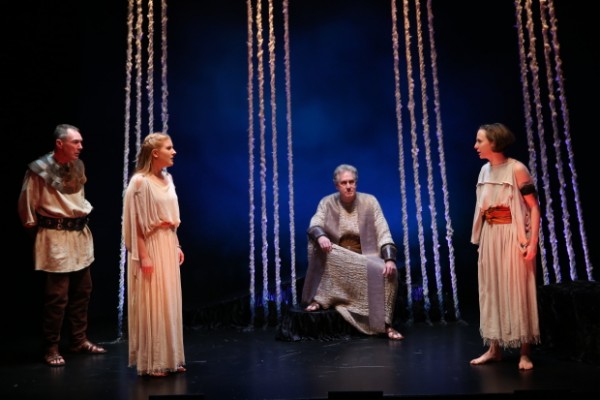
The Irish Rep’s version of Seamus Heaney’s adaptation of ANTIGONE continues at the DR2 Theatre through March 6 (photo © Carol Rosegg)
Irish Repertory Theatre
DR2 Theatre
103 East 15th St. between Irving Pl. & Park Ave.
Tuesday – Sunday through March 6, $70
212-727-2737
www.irishrep.org
In 2003, Dublin’s Abbey Theatre asked poet and translator Seamus Heaney to do a new version of Sophocles’ Antigone, a kind of follow-up to the Irish Nobel laureate’s only other play, The Cure at Troy, a 1990 adaptation of the Greek playwright’s Philoctotes. Heaney, who passed away in August 2013 at the age of seventy-four, hesitated in accepting the request until he found an angle that intrigued him: focusing on the treatment of the body of Polyneices, one of Oedipus’s two sons who killed each other while fighting on opposite sides of battle. King Creon decided to give Etocles a proper hero’s burial, while he ordered that Polyneices was to rot in the desert and that anyone who attempted to bury him would be executed. Heaney was ultimately inspired by his memories of the death of hunger-striking IRA prisoner Francis Hughes in 1981 as well as President George W. Bush’s determination to invade Iraq following 9/11. “Basically Creon turns Polyneices into a non-person, in much the same way as the first internees in Northern Ireland and the recent prisoners in Guantanamo Bay were turned into non-persons,” he said in a 2004 Jayne Lecture he gave at Harvard. “By refusing Polyneices burial, Creon claims ownership of the body and in effect takes control of his spirit, because the spirit will not go to its right home with the dead until the body is buried with due ceremony. When Antigone refuses Creon’s ruling and performs the traditional rites, her protest is therefore a gesture that is as anthropological as it is political, and it was only when I saw it in this light that I found a way out of the cat’s cradle of political arguments and analogies the play has become and could re-approach it as a work atremble with passion, with the human pity and terror it possessed in its original cultural setting.”
Unfortunately, the Irish rep’s current production, its last at the troupe’s temporary home at the DR2 Theatre, doesn’t take full advantage of Heaney’s powerful, poetic words in a staging that is woefully given short shrift, as if cobbled together at the last minute. Three-time Tony winner Tony Walton’s set feels like an afterthought, a tiny space with a couple of rocks, twelve strands of frayed rope descending from above, and a backdrop that changes colors throughout the show’s eighty minutes, occasionally oddly displaying an audience watching from behind. Linda Fisher’s drab costumes and Charlotte Moore’s barely there direction don’t add anything to what should have been a compelling investigation of honor, loyalty, and family. The ethical and moral conflict between Antigone and Creon fails to catch fire; Rebekah Brockman is too meek as the former, while Paul O’Brien, who stepped in late for the previously announced John Cullum and then Larry Bryggman in the role of Creon, never captures the poetry of Heaney’s words. The cast, who all seem to speak in different accents, also features Ciaran Bowling as Haemon, Creon’s son, who is engaged to marry Ismene (Katie Fabel), Antigone’s sister; Winsome Brown as Eurydice, Creon’s wife; Robert Langdon Lloyd as Tiresias, the blind soothsayer; Rod Brogan as the messenger; and Colin Lane, who fares the best as the squirmy guard. “What are Creon’s rights / When it comes to me and mine?” Antigone asks her sister at one point. The same can be asked of Heaney and the audience’s rights from this usually reliable troupe, which has done much better work in its twenty-six-year history.